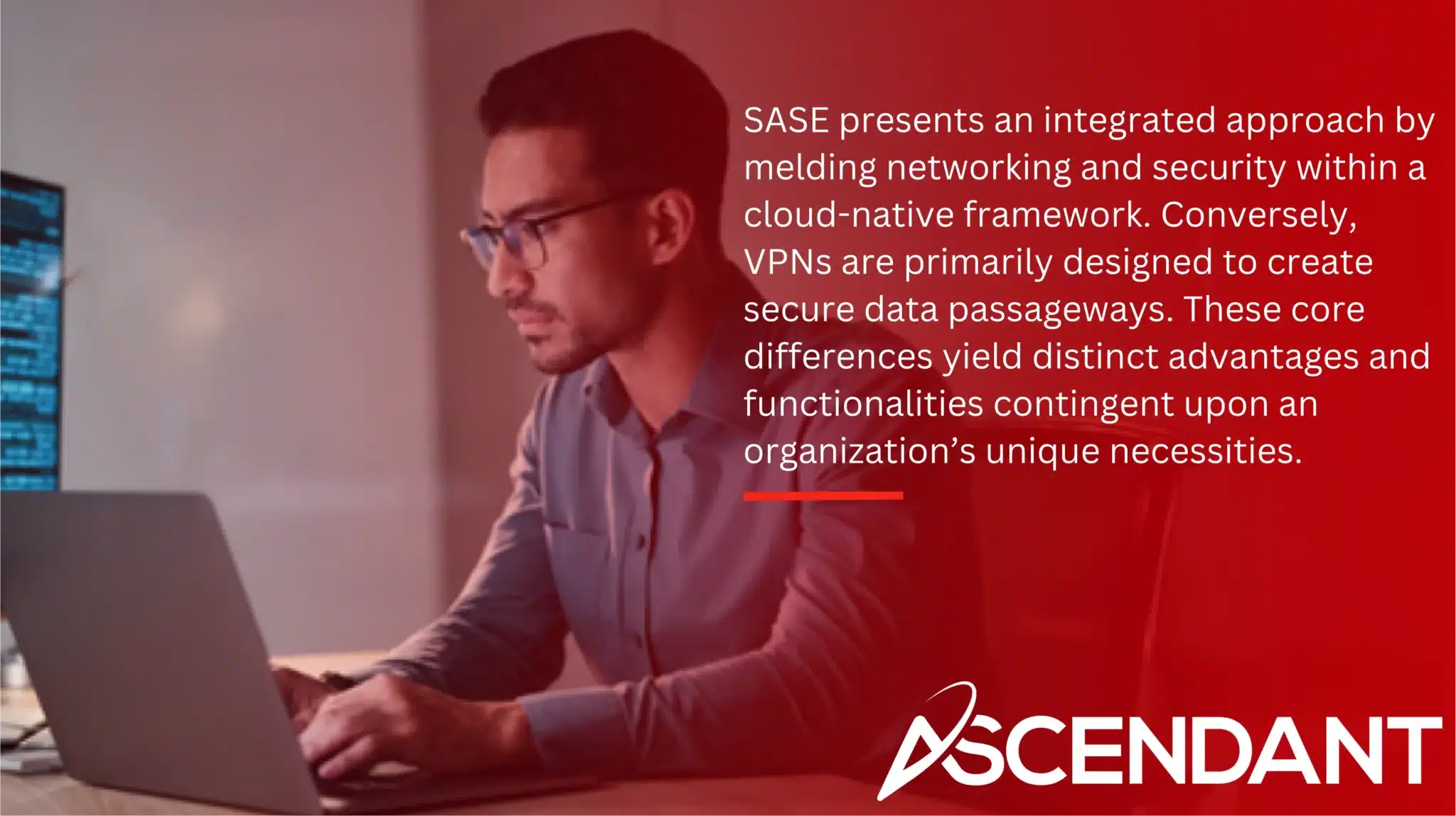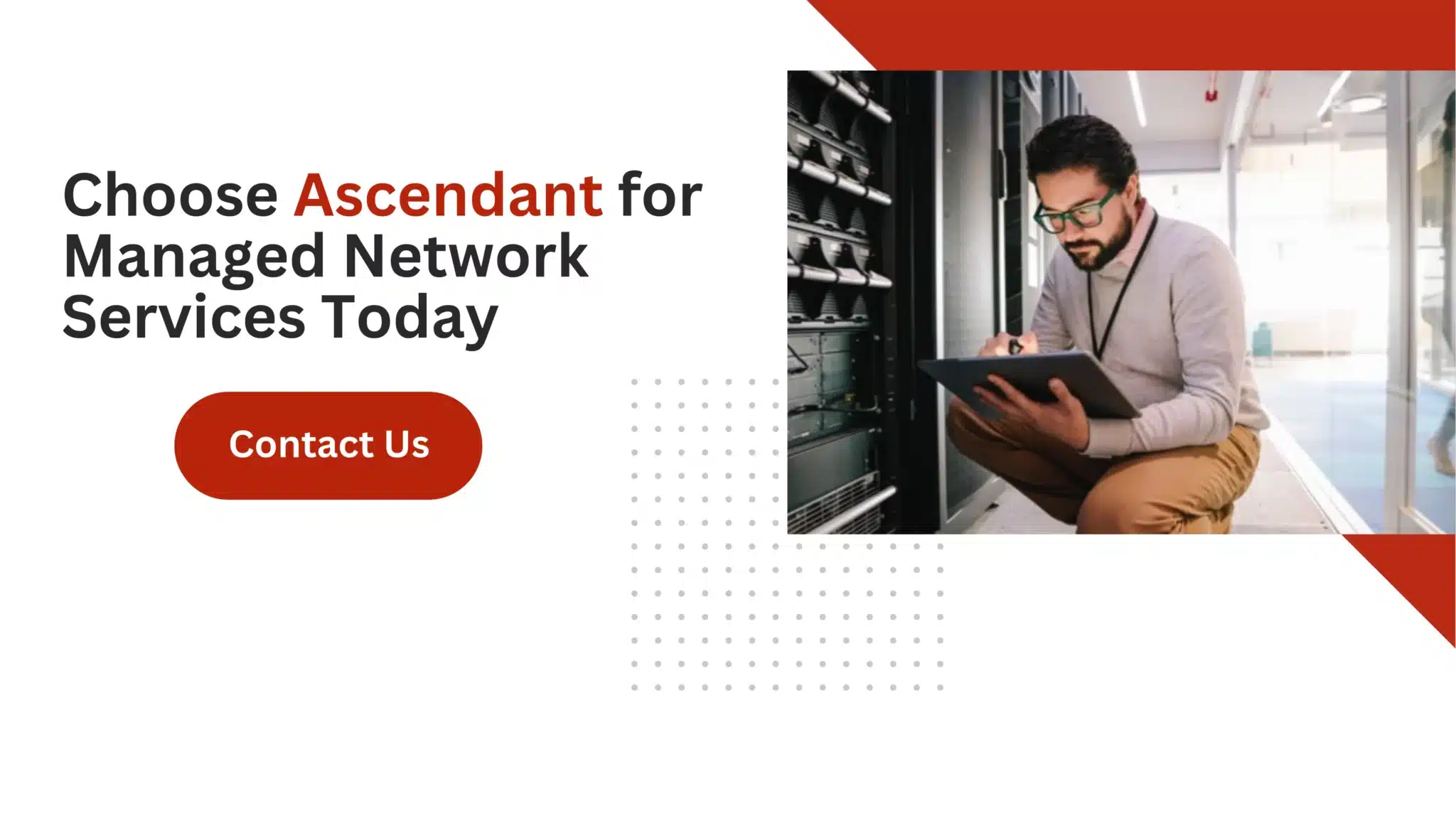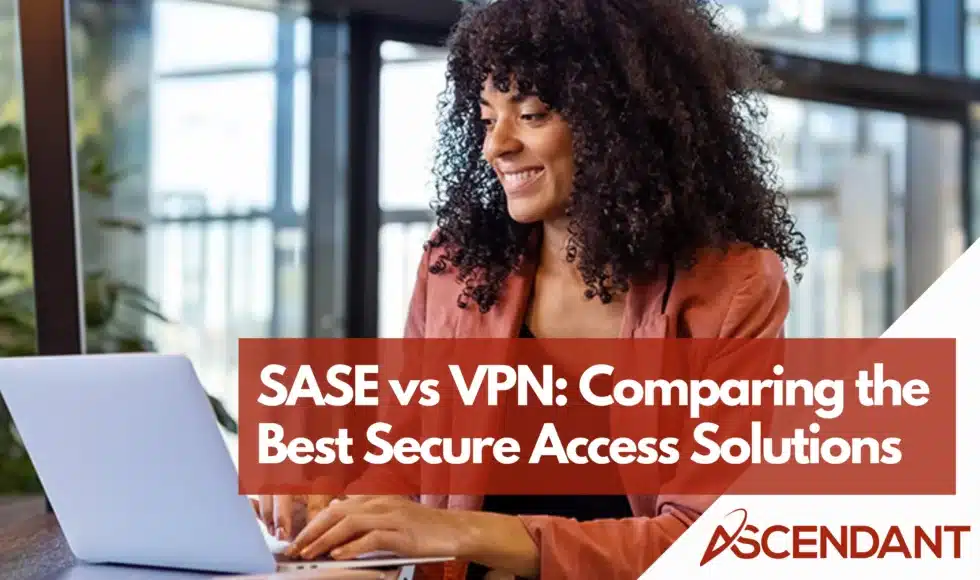This article delves into the critical distinctions between SASE and VPN, comparing these secure access solutions to assist you in determining which is most suitable for your organization’s requirements.
Key Takeaways
- SASE integrates networking and security services into a cloud-native solution, enhancing security and simplifying management for digital enterprises compared to traditional VPNs, which primarily focus on encrypted data tunnels.
- The SASE framework employs Zero Trust principles, continuously verifying user identities and providing robust security against evolving cyber threats, while VPNs are limited to securing data channels and user anonymity.
- Organizations should evaluate their specific security needs, network complexity, and long-term goals to decide between SASE and VPN, with SASE being more suitable for larger, remote workforces and complex network environments.
Understanding SASE and VPN
VPNs and SASE are both essential for ensuring secure access to cloud services and maintaining efficient connections within a company’s network. They serve to bolster business connectivity, enabling workforces that operate remotely or across the globe to utilize necessary applications and services. Given their distinct underlying principles and unique benefits, comprehending their fundamental operations is critical when choosing an appropriate solution for your organization.
Secure Access Service Edge, commonly known as SASE, introduces a revolutionary model of secure access by integrating robust security capabilities directly into the cloud infrastructure. This integration allows for safe, context-sensitive resource access – an advantage increasingly important in today’s environment where traditional network perimeters no longer exist.
In contrast stand VPNs, which have long been the standard choice for establishing secure remote access. Through creating secured tunnels over which data can be transmitted safely encrypted, only authorized individuals gain entry into the corporate network securing sensitive company information against unauthorized breach or exposure.
What is SASE?
The Secure Access Service Edge (SASE) brings forth a transformative cloud platform that fuses both networking and security services into one unified service. This integration epitomizes the amalgamation of cloud-controlled SD-WAN with security services delivered from the cloud, providing an all-encompassing solution catering to current enterprise needs in the digital era. By melding SD-WAN’s functionality with assorted security solutions, SASE simplifies the administration and fortification of network access.
A principal benefit of leveraging a SASE framework is its facilitation of pushing both security and access closer to user endpoints via edge computing technology, thus enhancing protection by pivoting away from traditional secure perimeter models towards focusing on individual users and their devices. The impetus behind adopting SASE lies in its capacity for minimizing complexity while simultaneously accelerating performance – attributes essential for supporting enterprises’ shift toward digital transformation – cementing it as fundamental within contemporary approaches to cybersecurity.
Enhancements within AI-driven SASE platforms are testaments to innovations in cloud-based architectures. These improvements incorporate artificial intelligence bolstered-security features which offer heightened defense mechanisms against threats.
What is a VPN?
A Virtual Private Network (VPN) is a long-standing technology that encrypts data as it travels over the internet, ensuring that only authorized users can access the network. This encryption creates a secure tunnel for data transmission, protecting user information from unauthorized access and potential breaches. By rerouting internet traffic through an alternate server, VPNs mask the device’s real IP address, enhancing user anonymity and privacy.
VPNs are particularly effective in concealing the origin of the connection and the data being exchanged, thus shielding users from potential trackers and prying eyes. As a result, a vpn service and vpn server is a popular choice for individuals and businesses aiming to maintain privacy and security while accessing the internet.
Whether it’s for remote access, securing internet connections, or protecting against surveillance, VPNs play a critical role in modern network security.
Key Differences Between SASE and VPN
Despite the shared goal of SASE and VPNs to safeguard access to network resources, there is a marked difference in their respective designs, security characteristics, and efficiency levels. It’s important for enterprises to understand these disparities in order to choose the solution that aligns optimally with their demands.

SASE presents an integrated approach by melding networking and security within a cloud-native framework. Conversely, VPNs are primarily designed to create secure data passageways. These core differences yield distinct advantages and functionalities contingent upon an organization’s unique necessities.
Architecture and Integration
SASE’s architecture is constructed to offer an integrated solution that merges security services with networking in a cloud-native fashion. In contrast to traditional VPNs which function autonomously and often necessitate distinct management systems, SASE unifies various security functions within one platform. This consolidation extends the conventional network perimeter, ensuring secure interaction with cloud resources and streamlining access management for geographically scattered employees.
While both SASE and VPN solutions enable secure remote connectivity to enterprise assets, their methods diverge significantly. The unified method of SASE facilitates centralized control over security protocols allowing for simpler administration and heightened effectiveness when compared against standard VPN configurations which can be more complex.
Security Features
The security model of Secure Access Service Edge (SASE) is founded on the principles of Zero Trust Network Access, which perpetually authenticates user identities and restricts data accessibility in alignment with their job requirements and established access controls. In contrast to traditional VPNs that mainly emphasize securing data transmission channels, this approach centers on identity management. SASE amalgamates various security services such as secure web gateways and intrusion prevention systems to forge an all-encompassing framework for security.
Through continuous monitoring of security metrics, SASE fine-tunes its policies to combat emerging threats effectively. This ongoing scrutiny ensures a dynamic maintenance of the system’s overall defensive stance—making it adept at countering new vulnerabilities and methods of attack more efficiently than conventional VPN solutions can offer.
Performance and Scalability
When selecting a solution for secure access, it’s essential to consider both performance and scalability. VPNs may create bottlenecks as they depend on a central server, which can result in slow connections that diminish the user experience. As the number of remote workers using a VPN grows, bandwidth concerns can exacerbate these performance issues.
Conversely, SASE architecture bolsters network performance by streamlining connection pathways and minimizing latency. This cloud-native approach enables centralized implementation of security protocols while enhancing scalability and adeptly managing the growth in remote users’ access demands.
Benefits of SASE Over VPN
To tackle the difficulties associated with legacy security infrastructure and remote working, SASE was conceived. With its foundation in the cloud, it provides a multitude of advantages compared to traditional VPN solutions, especially regarding network management, user experience, and enhanced security.
Enhanced Security Posture
SASE delivers an improved security stance by integrating SD-WAN with a suite of security services, creating a dynamic and formidable security structure capable of responding to changing cyber threats across various user settings. Its Zero Trust-based security model enhances the verification process for every access attempt, substantially bolstering overall safety.
Through its inherently cloud-native architecture, SASE effectively navigates the specific risks associated with dispersed infrastructures. It constantly monitors and updates its implementation to satisfy both performance standards and stringent security needs, thereby providing robust protection for remote access scenarios.
Improved User Experience
SASE markedly elevates the user experience, boosting efficiency with effective access measures that decrease latency and refine bandwidth distribution. Its cloud-native design affords agile connection governance, ensuring swift responsiveness and a more efficient user interface when contrasted with traditional VPNs.
By positioning data proximally to end-users, SASE reduces delays in transmission thereby expediting information retrieval and cultivating an optimized interaction. The constant supervision of network performance within the SASE framework aids in pinpointing restriction points, which is key to maintaining a streamlined operational environment that bolsters overall contentment among users.
Simplified Network Management
SASE streamlines the administration of networks by merging different networking and security services into a unified solution hosted in the cloud. By doing this, it cuts down on network intricacy and does away with the requirement for numerous individual solutions, thus facilitating easier management and enhanced security of the network.
To fine-tune SASE’s effectiveness, monitoring critical performance indicators (KPIs) is essential to evaluate its impact accurately and to make data-driven refinements. Such centralized management bolsters both network performance and protection, offering an experience that is more coherent and effective in managing networks.
When to Use VPNs
Even with the emergence of Secure Access Service Edge (SASE) solutions, Virtual Private Networks (VPNs) continue to be pertinent for certain situations. They serve well for organizations that have simple networking requirements or do not necessitate accommodating an extensive remote workforce.
Simple Remote Access Needs
VPNs serve as a perfect solution for basic remote access requirements, allowing remote workers to securely engage with the internet just as they would within an office setting. The convenience is especially advantageous for those who travel frequently, work remotely or are constantly on the move and need secure and private online access.
With robust encryption, a VPN enhances privacy protection for sensitive data, which is particularly crucial when using public Wi-Fi networks. It safeguards anonymity by concealing users’ IP addresses and offering added security during file-sharing processes. This makes VPNs an effective tool for maintaining confidentiality across different situations.
Cost-Effective Solutions
VPNs present an affordable solution for small businesses to achieve secure access, avoiding the complications that come with more sophisticated options. The streamlined nature of VPNs helps these smaller entities keep expenses under control while maintaining protected access to their networks.
When considering SASE and VPN solutions from a financial perspective, cost-efficiency becomes a significant factor for decision-making within small organizations. Due to their minimal expense and ease of deployment, VPNs are particularly attractive for companies operating on tighter budgets.
Choosing Between SASE and VPN
When deciding between SASE and VPN, organizations must conduct a detailed analysis of their unique demands, taking into account the scale of their remote workforce, the degree of data sensitivity involved, and the necessary security protocols.
To reach an educated conclusion on which solution to adopt, various considerations specific to the organization’s context need to be assessed.
Assessing Security Requirements
Assessing security needs is essential in deciding whether the all-encompassing method of SASE fits an organization’s profile. Both immediate and future financial impacts are significant factors in this evaluation process. By carefully examining both security requirements and fiscal aspects, organizations can select the appropriate access solution that aligns with their demands.
Evaluating Network Complexity
Evaluating the intricacies of a network is crucial in making an informed choice between SASE and VPN solutions. It’s imperative to provide IT personnel with thorough training on the novel SASE framework and its execution methods, which guarantees a seamless switch-over process. Continuous learning provides the IT department with vital capabilities for adeptly overseeing SASE frameworks.
Thorough instruction regarding the distinctive instruments and methodologies inherent to SASE is indispensable for effectuating a smooth shift. Such education certifies that IT teams are proficient in navigating through the challenges presented by SASE, thus enhancing both network performance and security levels.
Considering Long-Term Goals
Considering long-term goals is pivotal in choosing between SASE and VPN. SASE simplifies network management and enhances performance with integrated services, making it more scalable for future needs. Its low latency and optimal performance support the growing flexibility required by modern enterprises.
Adopting SASE contributes to a comprehensive long-term IT strategy by improving security posture against evolving cyber threats. SASE’s cloud-native architecture allows for efficient management and visibility across the network, aligning well with long-term strategic goals.
Switching to SASE is pivotal for digital transformation, enabling secure access to applications and data from anywhere.
Transitioning from VPN to SASE
Transitioning to SASE from a VPN setup entails devising a strategic plan and implementing it in stages. This step-by-step method allows companies to recalibrate connections for the remote workforce and seamlessly merge SASE into current systems. Thanks to its cloud-native design, integrating SASE can be expedited, thus simplifying the shift.
Gradual Implementation
Implementing SASE in a controlled, stepwise fashion allows companies to begin on a smaller scale, learn from the early stages, and then expand with assurance. It’s important for organizations to set precise goals for their SASE initiative that address specific requirements such as facilitating remote access and supporting international business activities. To boost both network efficiency and protection during setup, it is beneficial to chart out where users are located relative to cloud assets.
By involving teams responsible for security alongside those who oversee network operations, you create an all-encompassing strategy addressing both security measures and network throughput. Adopting a gradual deployment can lower the dangers involved in moving away from established setups like MPLS networks. This includes focusing on the closeness of Points of Presence (PoPs), which serves to better performance by reducing delay times experienced by off-site users. Gaining endorsement from executive leadership highlights the integral role SASE plays not only as a mechanism promoting expansion but also fortifying overall security systems within an organization.
Training and Support
It is critical to educate IT personnel thoroughly for the effective deployment and administration of SASE frameworks. By offering supportive resources throughout the changeover period, you can empower your IT staff to effectively tackle any emerging issues.
With a proficiently trained IT crew in place, they will be able to fully leverage SASE advantages, thus improving both security measures and overall work efficiency.
Monitoring and Optimization
Persistent surveillance ensures that SASE provides the highest level of performance and security benefits. Through its extensive delivery of security services, SASE strengthens the defense posture against threats to corporate networks. It also enhances user satisfaction by maintaining low latency and providing robust support for remote workers.
By merging various security features and networking capabilities into a single unified service, SASE streamlines network management. Transitioning from traditional VPNs to SASE necessitates a strategic plan for seamless integration with existing infrastructure elements. Employing a phased roll-out can facilitate an organization’s adjustment to SASE while reducing operational interruptions.
It is critical to offer comprehensive training and assistance in order for IT personnel to proficiently manage the new functionalities introduced by implementing a SASE solution.
 Summary
Summary
Choosing the right secure access solution is paramount in today’s digital landscape. SASE offers a comprehensive, integrated approach that improves security, performance, and user experience, making it a strong contender for organizations undergoing digital transformation. VPNs, while still relevant for simple remote access needs and cost-effective solutions, may fall short in addressing the complexities of modern network security. By understanding the key differences and benefits of each solution, organizations can make informed decisions that support their long-term goals.

